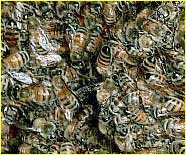The Chemistry of Bees

Or, to be a bit more exact, the chemistry and chemicals used by the European honeybee, Apis mellifera. Other species of bee use the same sorts of chemicals, but aren’t generally as complicated as the honeybee in terms of society and behaviour.

I’ve tried to cover all the main areas that bees used specialised chemistry for, such as honey, wax, propolis, sting venom, and royal jelly; and discuss the pheromones that bees use to communicate with each other. However, some of these pages do not include any chemistry at all - for example the bee dancing page.

Honeybees are social insects, living in colonies of up to about 60,000 individuals. The colony is highly complex, and each bee works for the good of the entire hive. The colony centres around its queen, a fertilised female capable of laying around a thousand eggs every day. In addition, there are up to 60,000 worker bees (non-reproductive females), and up to 1,000 male bees, or drones. Female honeybees are equipped with a venomous sting.
Unsurprisingly, the main source of carbohydrates for bees is honey. Pollen collected from the anthers of flowers provides the essential proteins necessary for the rearing of young bees. In the act of collecting nectar and pollen, bees pollinate the flowers they visit. Honeybees also collect propolis, a resinous material from buds of trees, for sealing cracks in the hive or for covering foreign objects in the hive that they cannot remove. They collect water to cool the hive and to dilute the honey before they consume it. A well-populated honeybee colony in a good location may collect as much as 450 kilograms of nectar, water, and pollen per year.

In summer, when sources of nectar and pollen are abundant, more honey is produced than is needed, and is stored in the combs. This abundance of food stimulates the queen's egg-laying, and large numbers of eggs are laid in the broodnest. When large numbers of young bees hatch, the hive becomes crowded, and swarming occurs as the surplus bees search for a new home.
Honeybees regulate the temperature of the hive using water as a coolant, and by beating their wings to circulate air. The temperature of the hive is maintained between 35 and 36°C regardless of outside temperature. If water is available, a colony can survive daily maximum temperatures of 49°C. When the temperature falls below about 14°C the bees cease flying, cluster together in the hive to conserve heat, and await the return of warm weather. They can survive in temperatures as low as -46°C for several weeks.

This site was created by
Joel Loveridge
School of Chemistry
University of Bristol
UK
Email el9631@bris.ac.uk